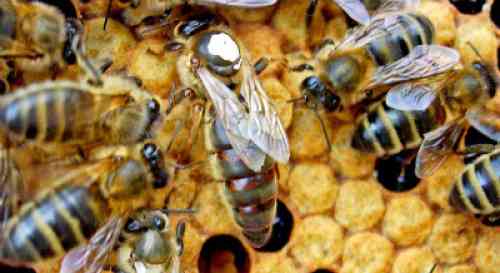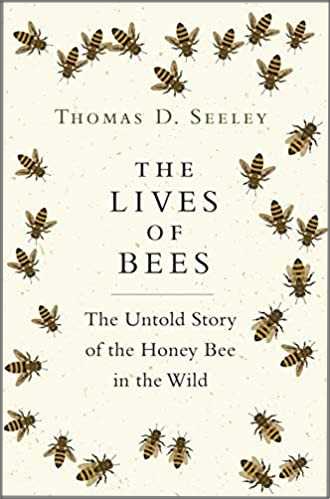Marking The Queen With Bee Paint
Date: 24th March 2021
Although the queen is larger and has a longer body than the workers and drones in a colony of honey bees, it can nevertheless be a challenge to identify her quickly in the hive. For this reason, beekeepers use a special paint which is carefully and lightly dabbed on to the thorax of the queen. In this way, the queen can more easily be recognized on the frame by the spot of paint.
More reasons to mark the queen with bee paint
 Above, a honey bee queen is easier to identify among workers when marked.
Above, a honey bee queen is easier to identify among workers when marked.Beekeepers do not always mark the queen, but there are a number of advantages. A little dab of paint carefully applied to the thorax of the queen, may be a fiddly task but can save much time later.
- If you mark the queen, but subsequently find an unmarked queen in the hive, the queen may have been superceded, or requeened itself after swarming. However, it is also possible the paint has worn off.
- If you use a colour marking system (see below) it will be easier for you to tell the age of the queen.
Marking the queen - tools and method
It's worth taking the time to be careful and it's helpful to have a little equipment ready and prepared to ensure the delicate queen is not damaged or harmed in any way. You want to make sure the paint does not end up where it's not supposed to, such as on the wings, eyes, head. You'll also want to avoid injury, especially to her legs. Her legs are very important but easily trapped or squashed. The queen uses her legs to help her squat in the correct position for egg laying.
Tools needed:
- Mann Lake One-handed queen catcher
This is a small, hand-held queen catcher and is a useful and recommended tool, specially designed to safely capture the queen. It features narrow slits to enable you to apply the paint, and a 'push' mechanism to ensure the nib of the pen reaches the queen without causing harm. - Paint
Special bee paint is available and recommended, but model paint is sometimes used. However, special sets of queen marking pens are great - check the water-based POSCA brand. Each set of 5 pens comprises one each in white, blue, yellow, red and green to tie in with the internationally agreed colour coding system (more about this below).
Method
Using the queen catcher, carefully remove the queen from the hive. Try to ensure you catch only the queen and as few workers as possible - preferably no workers. Workers inside the queen catcher with the queen will tend to lick the paint off her once applied. Blow workers away, or use a goose feather to gently shoo them.
Apply the paint - as stated above, a specially designed pen containing bee paint is recommended, such as POSCA mentioned above, because it makes the process easier and potentially safer for the queen. Allow the paint to dry before releasing her back to the colony.
Below is a handy short video demonstrating the method simply:
Colour coding system for queens
If you only have one hive and keep notes, white paint should suffice. However, the internationally agreed system of colour-coding honey bee queens provides a standardized means to be certain of her age. The system repeats itself every 5 years:
If you found this page helpful or interesting, I'd really be grateful if you would share it with others - if not this page, perhaps another, such as Gardening For Bees.
Thank you so much :) .
